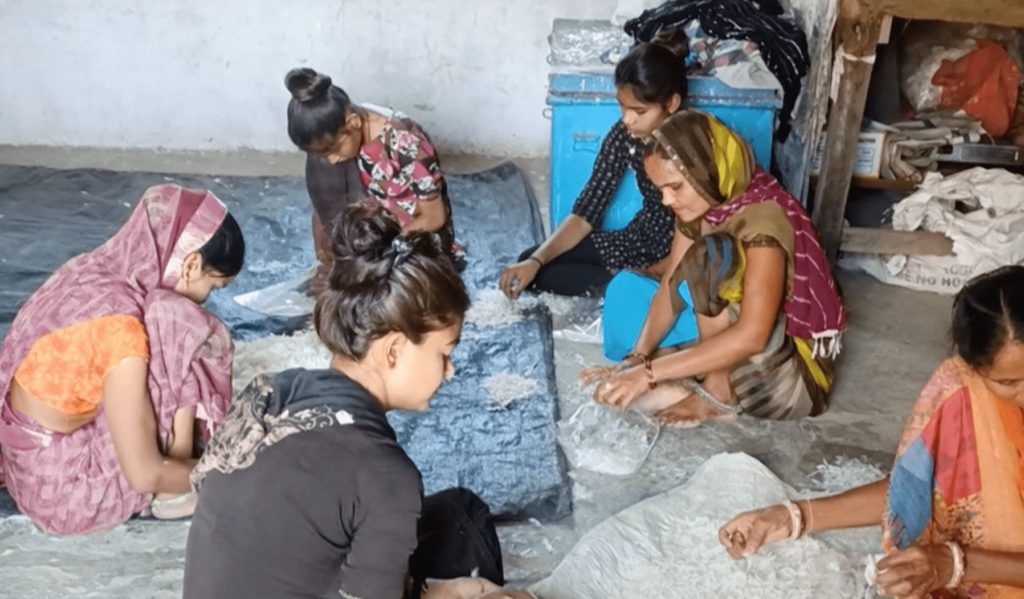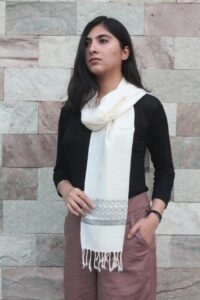Mudita & Radhesh Private Limited
Mudita & Radhesh Private Limited is an innovative social enterprise established in 2017 that aims to transform the lives of tribal women in India through sustainable development. Mudita & Radhesh Private Limited has developed a new natural wool-like fibre by up-cycling feathers of chicken butchery waste. These feathers, spun into yarn, become ten times warmer, softer, and more durable than any other natural and synthetic fibre.
Problem Statement
The poultry industry in India now is the fastest-growing segment of the livestock sector at an annual growth rate of 12.39%. Butchery Chicken Waste (BCW) is undoubtedly a significant source of pollution globally, especially in India, because of the very high consumption rate. On average, 1 kg of chicken produces 300 gm of BCW which contains 70 gm of feathers and generates 6.9 kg of carbon footprint. Over 3.6 billion tonnes of butchery waste is dumped into rivers and water bodies each year (Delhi NCR and Uttar Pradesh), and butchery waste pollutes uninhabited areas, landfills and 32% of waste dumped in the Yamuna River is attributed to chicken waste. BCW is usually thrown in gutters, water bodies, landfills, and open areas by butchers, causing water pollution, air pollution, flu, and other health hazards.
Project Implementation
Mudita & Radhesh convert large amounts of BCW into premium quality wool, thread and handloom cloth to reduce wastage, pollution and health hazards. The waste is collected from various butcher shops and is processed in our unit using a patented environmentally friendly method to extract 5-7% wool – 70 gm per kilogram of chicken waste. The waste is hygienically sanitised across over 26 processes before extracting the feather wool. The extracted chicken feathers are converted into pulp and yarn for handloom cloth. Tribal women are employed to carry out hand-carding, spinning weaving to make this into a fabric that is durable, light, wearable, and yet warmer, lighter and softer than any other natural and synthetic woollen fibres. This process does not just involve and employ tribal women but waste collectors who add value to this waste collection process. The by-product from the process is scientifically converted into compost and distributed to local farmers as fertiliser.
Processing and upcycling BCW into fabrics.
Intersectionality and Impacts
From Waste to Value
In the last three years, 3.5 million kilograms of BCW has been converted into handloom cloth and compost. It has prevented the pollution of 350 tonnes of waste into landfills and water bodies. The quality of their fibre is very soft, lightweight & durable, which will not be worn out by environmental changes/damage for 50 to 70 years like any other woollen fabric. It is the best alternative to replace natural & synthetic fibres. Furthermore, synthetic, cotton, wool and other fibres take 6-8 months to reach the consumers, while feather fibre takes only one week, making it the quicker, cheaper, durable and environmentally friendly alternative for the end users.
An example of a scarf made from BCW.
Livelihood Generation
Mudita & Radhesh have successfully generated livelihood for 6000 women registered with them, where 1200 work with them regularly, get trained to weave the fabric produced into products and earn a dignified livelihood. This has created close to 250 Self-Help Group clusters of 20 each around Jhalawar city of Rajasthan.
The organisation processes 10,000 kg of chicken waste monthly and employs over 200 tribal women living in tribal, backward areas of Jhalawaad, Rajasthan, India. It gives the tribal women a secure and dignified livelihood. A tribal woman worker can earn an average monthly income of INR 10000, ten times the average income, including free meal time daily and family benefits. 25% of their profit is for tribal community welfare, small loans, children’s education, health, and natural disasters.
Scalability of the Project
Their work focuses on the problem caused by waste that pollutes landfills and water bodies and addresses it by repurposing BCW into various handloom products like running cloth, quilts, shawls, jackets, embroidery, stoles, mufflers, woollen fabric, garments and apparels. They are also venturing into repurposing single-use garbage materials like chips packaging, newspapers, magazines, tire tubes etc.
The pandemic had a devastating effect on the textile sector, including Mudita & Radhesh. Mudita & Radhesh is among a few of those startups which was able to sustain, recover and is currently gaining momentum. Unlike other alternative textile material producers, the ambition of Mudita & Radhesh is not to focus on a premium market but to create a sustainable and affordable alternative for the masses. Integrating this solution into the existing value chain of the textile industry and developing the ecosystem around chicken feather-based textile is also rather resource intensive. Furthermore, they convert only 30% of the spinnable feathers into textile products. Fortunately, they have successfully developed paper out of non-spinnable feathers and are currently focusing on starting production at a scale of the same.
Videos
https://www.dw.com/en/india-recycling-chicken-feathers-helps-tribal-women/video-65724904




















